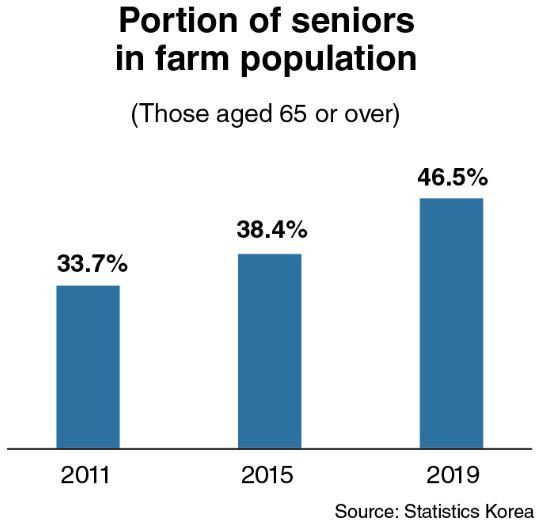[News Focus] 46% of farm population aged 65 or over in Korea
Under-60 make up only 39% in agricultural sector
By Kim Yon-sePublished : March 7, 2021 - 12:34

SEJONG -- South Korea’s agricultural regions are aging far faster than cities in demographic structure while the portion of elderly population is simultaneously climbing across the nation, state data showed.
According to Statistics Korea, the number of farm population stayed at an all-time low of 2.24 million in 2019, as young people have steadily relocated to urban areas.
The nation’s farm population refers to those engaging in agriculture and family members residing in the same households.
Seniors, aged 65 or over (1.04 million people), made up 46.5 percent of the total farming population, the highest percentage since the government started compiling the data.
The figure was higher by 1.9 percentage points than a year earlier, and well up from 33.7 percent in 2011.

Extending the age range downward, 60.6 percent of the farm population were aged 60 or over in 2019. With less than 40 percent in proportion for those under 60, a serious shortage of workers looms for the agricultural sector in the coming years and decades.
By age group -- from those aged 0-4 to those aged 80 or over -- those aged 60-64 topped the list at 314,191, followed by those aged 65-69 at 293,059, those aged 70-74 at 268,162, those 80 or over at 247,784 and those 75-79 at 236,703.
The next rankers were those aged between 55-59 at 235,567, those aged 50-54 at 143,101 and those aged 45-49 at 94,199.
All of the age groups under 45 -- such as those aged 40-44 and those aged 35-39 -- posted under 60,000 respectively.
The 46.5 percent contrasts to 15.5 percent in 2019 (16.6 percent as of February 2021) in the portion of entire seniors for the nationwide including both rural and urban areas.
“Those in their 60s are regarded as the de facto youngest in rural regions. They are actively helping neighbors in their 80s doing arduous jobs like moving heavy fertilizer packs,” said an official of the Ministry of Agriculture, Food and Rural Affairs.
In the 2010s, the government provided young urbanites in their 20s, 30s and 40s, who moved to rural areas and tapped the farming sector, with a variety of benefits, which encouraged a trend to return to agriculture.
But the trend is seemingly waning, as many of them have failed to adapt themselves to rural life.
Among the core problems they picked were difficulty getting along with their new neighbors, a lack of farming know-how and financial difficulties due to reduced earnings.
Agriculture Ministry data showed that the tally for people who continued farm work after moving from urban areas stood at 17,856 as of 2018, down more than 1,500 from 19,630 in 2017. This was the second consecutive year of decline after the population peaked at 20,559 in 2016.
The 2.24 million farm population made up only 4.3 percent of the entire Korean population, which was also the record-low.
According to unofficial figures, 45.7 percent of the population were working on farms in 1970, 28.4 percent in 1980 and 8.8 percent in 2000.
After posting 6.2 percent in 2010, their proportion further dropped to 5.6 percent in 2013, 5 percent in 2015 and 4.7 percent in 2017.
By sex, the number of men engaged in agriculture slid from 1.5 million in 2010 to 1.09 million in 2019. The number of women fell from 1.56 million to 1.14 million.
In a similar vein, the portion of people working in the forestry sector declined from 0.5 percent of the entire population to 0.3 percent over the corresponding 2010-2019 period. The fishery population percentage inched down 0.1 percentage point to 0.2 percent.
By Kim Yon-se (kys@heraldcorp.com)











![[Today’s K-pop] BTS pop-up event to come to Seoul](http://res.heraldm.com/phpwas/restmb_idxmake.php?idx=644&simg=/content/image/2024/04/17/20240417050734_0.jpg&u=)




![[KH Explains] Hyundai's full hybrid edge to pay off amid slow transition to pure EVs](http://res.heraldm.com/phpwas/restmb_idxmake.php?idx=652&simg=/content/image/2024/04/18/20240418050645_0.jpg&u=20240419100350)

